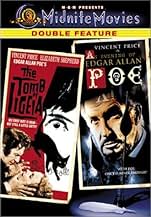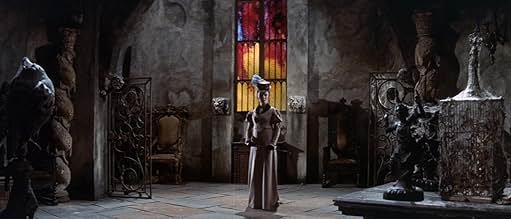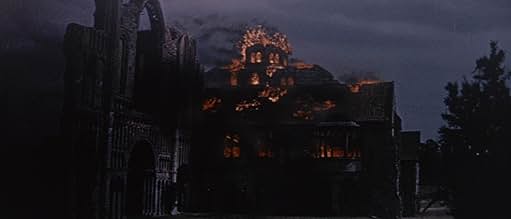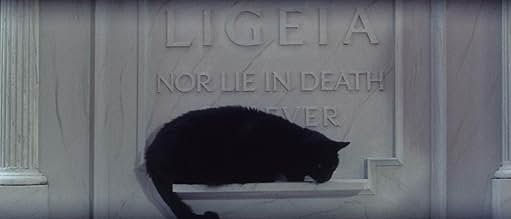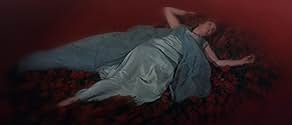VALUTAZIONE IMDb
6,4/10
7267
LA TUA VALUTAZIONE
L'ossessione di un uomo per la moglie morta crea tensioni tra lui e la sua nuova sposa.L'ossessione di un uomo per la moglie morta crea tensioni tra lui e la sua nuova sposa.L'ossessione di un uomo per la moglie morta crea tensioni tra lui e la sua nuova sposa.
- Regia
- Sceneggiatura
- Star
Maxwell Craig
- Wedding Guest
- (non citato nei titoli originali)
Anthony Lang
- Wedding Guest
- (non citato nei titoli originali)
Del Watson
- Footman
- (non citato nei titoli originali)
Fred Wood
- Wedding Guest
- (non citato nei titoli originali)
Recensioni in evidenza
Amidst a crumbling castle in 19th century England, a widowed aristocrat (Vincent Price) mourns his wife, but quickly develops a new romantic relationship after meeting the forceful Rowena (Elizabeth Shepherd). Yet the soul of Ligeia seems to be haunting the estate and the apparently mesmerized Baron is hiding something.
Released in late 1964, "The Tomb of Ligeia" is Gothic horror based on the Edgar Allan Poe story from 1838 (which was revised in 1845 with the addition of his 1843 poem "The Conqueror Worm," written by the character Ligeia). This was the last of Roger Corman's eight Poe films from 1960-1964, which all made money but this one made the least, possibly because the quasi-series had run its course and the story was overly complicated. Nevertheless, Corman considered it one of the best of the lot.
Since the original tale was so short, scriptwriter Robert Towne incorporated elements from other Poe stories, such as the black cat, mesmerism and a hint of necrophilia. The talky story isn't as compelling as Corman's "The Terror" (1963) or even "The Masque of the Red Death" (1964). It's rather boring for the first hour, but there's an effectively creepy payoff in the last act, which ties everything together. Like those previous two films, the sumptuous Gothic ambiance is worth the price of admission and the inclusion of Stonehenge is a highlight. You just have to acclimate to the dated drama-focused goings-on.
The movie runs 1 hour, 22 minutes and was shot at Shepperton Studios, just west of London, and Castle Acre Priory north of Swaffham, as well as other spots in England, such as Stonehenge, Polesden Lacey and Polzeath, Cornwall, at the southwest tip of Britain (the beach scene).
GRADE: B-/C+
Released in late 1964, "The Tomb of Ligeia" is Gothic horror based on the Edgar Allan Poe story from 1838 (which was revised in 1845 with the addition of his 1843 poem "The Conqueror Worm," written by the character Ligeia). This was the last of Roger Corman's eight Poe films from 1960-1964, which all made money but this one made the least, possibly because the quasi-series had run its course and the story was overly complicated. Nevertheless, Corman considered it one of the best of the lot.
Since the original tale was so short, scriptwriter Robert Towne incorporated elements from other Poe stories, such as the black cat, mesmerism and a hint of necrophilia. The talky story isn't as compelling as Corman's "The Terror" (1963) or even "The Masque of the Red Death" (1964). It's rather boring for the first hour, but there's an effectively creepy payoff in the last act, which ties everything together. Like those previous two films, the sumptuous Gothic ambiance is worth the price of admission and the inclusion of Stonehenge is a highlight. You just have to acclimate to the dated drama-focused goings-on.
The movie runs 1 hour, 22 minutes and was shot at Shepperton Studios, just west of London, and Castle Acre Priory north of Swaffham, as well as other spots in England, such as Stonehenge, Polesden Lacey and Polzeath, Cornwall, at the southwest tip of Britain (the beach scene).
GRADE: B-/C+
Of all the collaborations between director Roger Corman and sensuous, creepy actor Vincent Price, this is probably their best. There's the small cast of characters, mainly Ligeia, buried in a marble tomb in the grounds of a sinister old abbey, Rowena, a lady horserider looking for someone she can be 'drawn' to who is more interesting than her beau Christopher, and Verdon, Ligeia's bereaved husband, with his black shades and mood swings. There's also a cat. And this cat is really the true star of the film, watching, attacking, influencing.
The film benefits from its heavy use of locations, and makes it stand apart from the studio interiors of other adaptations. This is a decadent, decaying England with strange happenings and curses. It is a superb film, and lifts the Shepperton Poe adaptations to a new level.
The film benefits from its heavy use of locations, and makes it stand apart from the studio interiors of other adaptations. This is a decadent, decaying England with strange happenings and curses. It is a superb film, and lifts the Shepperton Poe adaptations to a new level.
Well, at least for a little while! His last of eight Poe films as director is (loosely) based on the Poe work of the same name and is a solid metaphorical ghost story. Lady Rowena (the wonderful Elizabeth Shepherd) falls in love with Verden Fell (Vincent Price) despite his strange behavior and questionable past. Soon after their marriage, he starts disappearing, she's menaced by that old Poe stand-by (the evil black cat) and plagued by horrific nightmares involving Verden's deceased former wife Ligeia (also played by Shepherd), whose ghost seems intent on ruining the union. Price, in top hat and strange sunglasses in many scenes (his vision being "dangerously acute"), seems a bit too old for the role, but still manages to come through with an effective performance. Corman has always been underrated for effectively capturing period detail on a limited budget and it's his keen eye for the crumbling ruins, lush green countrysides, oceanfronts and shadowy castle corridors that make much of this film work. Screenplay by future Oscar-winner Robert Towne (CHINATOWN). LIGEIA was Corman's last horror film as director until 1990's FRANKENSTEIN UNBOUND.
There is an assumption among movie fans that the longer a movie series exists, the worse the later films will be. Although the films Roger Corman made of some of the stories of Edgar Allan Poe began well and continued with no obvious sense of decline, it is my opinion that the best was kept for last. The most overtly spectacular film in the series was 'The Masque of the Red Death' with its fine sense of colour and effective sense of homage to Ingmar Bergman's 'The Seventh Seal'. I have always enjoyed this film and in terms of a deliberate departure from the series norm, it is exceptional. However one enjoys any series for the familiar as well as the unusual, and in this respect 'The Tomb of Ligeia' is the most memorable for me in the way it builds upon and enhances what has gone on in previous films. The logical departure from the previous films which had been (very happily and effectively) studio-bound, was to move to location. Corman's choice of Castle Acre Priory in Norfolk, was an inspired one. An large amount of location filming was done there and this grounded the film in a realistic (yet unusual)setting. Gone were the fog machines and 'blasted heath' effects of 'House of Usher' and 'The Premature Burial'. Many critics have mentioned their disquiet at the absence of Barbara Steele, at that time undoubtedly the actress most associated with this type of picture. Wonderful though Miss Steele was in, say, the last thirty minutes of 'The Pit and the Pendulum', I feel that the presence of the English actress, Elizabeth Sheppard, adds to the sense of realisim, while taking little away from the shock effect of one actress playing both a good and an evil role. Roger Corman is on record as saying that he had to keep a written record as to when Rowena was herself and when she was Ligeia. All I can say that it is happily obvious on the screen when each side of the romantic coin is in evidence. I think that Elizabeth Sheppard's performance, grounded in reason, and when added to the inevitable polish that was being obtained by this stage in the series, showed a welcome extra sense of belief, to point out the advances and progression that had been made by this, the last film, in the series. Two scenes stand out : the entrapment of Rowena in the bell tower by the black cat (representing Ligeia.) I am also very impressed by Rowena's hynotism ; first to her own childhood and then to the persona of Ligeia. This film has not been available for viewing in the UK for many years. It is to be hoped that this situation will be reversed before long. I remember with affection the moment when great talents (from both sides of the 'pond') collaborated with great effcetiveness to come up with the ultimate 'Corman Classic'.
"The Tomb of Ligeia" was one of a cycle of films made by Roger Corman in the sixties based on the works of Edgar Allen Poe. Verden Fell, an English country gentleman of the 1820s has become obsessed with his dead wife Ligeia. Indeed, although she has been buried in a tomb he built for her, he believes that she is not dead but has, as she promised she would, survived death in some form and will return to him. This obsession survives Fell's remarriage to Rowena, the daughter of a neighbouring landowner. Indeed, his obsession worsens, as he comes to believe that Rowena is possessed by Ligeia's spirit.
This is an unusual horror film in that much of it takes place not only outdoors but also in daylight. The sort of images of ruin and decay traditional in horror films- Fell lives in a gloomy, crumbling, cobwebbed manor house close to the ruins of a mediaeval abbey- are contrasted with sunlit scenes of the beautiful, verdant English countryside. The difference between life and death is the central idea of the film- which ends with a quote from Poe himself: "The boundaries which divide life from death are at best shadowy and vague. Who shall say where the one ends and where the other begins"- so this contrast is possibly symbolic, with the outdoor scenes symbolising life and the indoor ones death. The two main female characters (both played by the same actress, Elizabeth Shepherd) are differentiated in a similar manner. Rowena is a healthy-looking, "English Rose" type blonde with a love of outdoor pursuits, especially hunting. Ligeia is dark haired and gaunt with an unhealthy pallor.
Like many films of this period, and unlike later films such as "The Exorcist", this is an example of an understated horror film, with the horror mostly being implied rather than shown directly. Ligeia makes an appearance in the film, but we are never sure whether this is really her ghost returning from the grave or a hallucination conjured up by Fell's distraught mind. Although it is understated, however, it is genuinely frightening, not because of Exorcist-style special effects, but because of the eerie mood that Corman is able to create. Apart from the atmospheric setting, various objects take on a sinister significance- a bunch of flowers, a dead fox and, most of all, a mysterious, malevolent black cat which may be the reincarnation of Ligeia's soul, or may be just a cat.
The acting is also very good, especially from Shepherd in the dual role of Rowena/Ligeia and from Vincent Price as Fell. In a way this is also a dual role, as there are two separate aspects to Fell's character. On the one hand he is sinister and frightening, the man who threatens Rowena's happiness, her sanity and even her life. (The adjective "fell" significantly means cruel or fierce). On the other hand he is a pitiable character, a victim of his own obsessions and (possibly) also of his late wife's ghost. This duality is very much in keeping with the mood of the film, which is one of ambiguity and doubt. As befits one based upon the work of Poe, it is a tale of mystery and imagination. 7/10
This is an unusual horror film in that much of it takes place not only outdoors but also in daylight. The sort of images of ruin and decay traditional in horror films- Fell lives in a gloomy, crumbling, cobwebbed manor house close to the ruins of a mediaeval abbey- are contrasted with sunlit scenes of the beautiful, verdant English countryside. The difference between life and death is the central idea of the film- which ends with a quote from Poe himself: "The boundaries which divide life from death are at best shadowy and vague. Who shall say where the one ends and where the other begins"- so this contrast is possibly symbolic, with the outdoor scenes symbolising life and the indoor ones death. The two main female characters (both played by the same actress, Elizabeth Shepherd) are differentiated in a similar manner. Rowena is a healthy-looking, "English Rose" type blonde with a love of outdoor pursuits, especially hunting. Ligeia is dark haired and gaunt with an unhealthy pallor.
Like many films of this period, and unlike later films such as "The Exorcist", this is an example of an understated horror film, with the horror mostly being implied rather than shown directly. Ligeia makes an appearance in the film, but we are never sure whether this is really her ghost returning from the grave or a hallucination conjured up by Fell's distraught mind. Although it is understated, however, it is genuinely frightening, not because of Exorcist-style special effects, but because of the eerie mood that Corman is able to create. Apart from the atmospheric setting, various objects take on a sinister significance- a bunch of flowers, a dead fox and, most of all, a mysterious, malevolent black cat which may be the reincarnation of Ligeia's soul, or may be just a cat.
The acting is also very good, especially from Shepherd in the dual role of Rowena/Ligeia and from Vincent Price as Fell. In a way this is also a dual role, as there are two separate aspects to Fell's character. On the one hand he is sinister and frightening, the man who threatens Rowena's happiness, her sanity and even her life. (The adjective "fell" significantly means cruel or fierce). On the other hand he is a pitiable character, a victim of his own obsessions and (possibly) also of his late wife's ghost. This duality is very much in keeping with the mood of the film, which is one of ambiguity and doubt. As befits one based upon the work of Poe, it is a tale of mystery and imagination. 7/10
Lo sapevi?
- QuizShot on a 25 day schedule in the UK, a big difference to the 15 day schedule used in the US for the previous Roger Corman "Poe" movies. The director attributed the extra time to the British crew's obsession with taking "tea breaks."
- BlooperPosition of Ligeia's arms when lying in bed. When Rowena fall on her her arms are in a position like holding something. Few minutes later, when Verden take a look on the bed hidden by the black curtains, their arms are in other position.
- Citazioni
Verden Fell: Christopher, not ten minutes ago I... I tried to kill a stray cat with a cabbage, and all but made love to the Lady Rowena. I succeeded is squashing the cabbage and badly frightening the lady. If only I could lay open my own brain as easily as I did that vegetable, what rot would be freed from its grey leaves?
- ConnessioniFeatured in Nightwatch Presents Edgar Allan Poe: The Tomb of Ligeia (1973)
I più visti
Accedi per valutare e creare un elenco di titoli salvati per ottenere consigli personalizzati
Dettagli
- Tempo di esecuzione
- 1h 22min(82 min)
- Colore
- Proporzioni
- 2.35 : 1
Contribuisci a questa pagina
Suggerisci una modifica o aggiungi i contenuti mancanti




